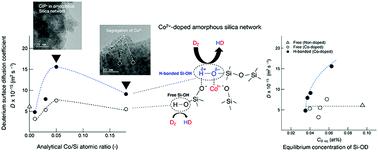当前位置:
X-MOL 学术
›
Inorg. Chem. Front.
›
论文详情
Our official English website, www.x-mol.net, welcomes your feedback! (Note: you will need to create a separate account there.)
Hydrogen transport property of polymer-derived cobalt cation-doped amorphous silica
Inorganic Chemistry Frontiers ( IF 7 ) Pub Date : 2020-10-21 , DOI: 10.1039/d0qi01035a Shotaro Tada 1, 2, 3, 4, 5 , Shiori Ando 1, 2, 3, 4, 5 , Toru Asaka 1, 2, 3, 4, 5 , Yusuke Daiko 1, 2, 3, 4, 5 , Sawao Honda 1, 2, 3, 4, 5 , Samuel Bernard 6, 7, 8, 9, 10 , Yuji Iwamoto 1, 2, 3, 4, 5
Inorganic Chemistry Frontiers ( IF 7 ) Pub Date : 2020-10-21 , DOI: 10.1039/d0qi01035a Shotaro Tada 1, 2, 3, 4, 5 , Shiori Ando 1, 2, 3, 4, 5 , Toru Asaka 1, 2, 3, 4, 5 , Yusuke Daiko 1, 2, 3, 4, 5 , Sawao Honda 1, 2, 3, 4, 5 , Samuel Bernard 6, 7, 8, 9, 10 , Yuji Iwamoto 1, 2, 3, 4, 5
Affiliation

|
The effect of the local structure of Co-doped amorphous silica on the hydrogen transport property was studied with the aim to improve the high-temperature hydrogen-permselectivity of microporous amorphous silica-based membranes. Co-Doped silica materials with measured Co/Si atomic ratios ranging from 0.01 to 0.18 were successfully synthesized through the polymer-derived ceramic (PDC) route. X-ray diffraction (XRD) and high-resolution transmission electron microscopy (HRTEM) analyses confirmed the amorphous state of the polymer-derived Co-doped silica, while both X-ray photoelectron and Fourier transform infrared (FT-IR) spectroscopy analyses revealed that the divalent Co cation (Co2+) modified the matrix amorphous silica network to form hydrogen-bonded silanol. After dehydration treatment at 500 °C in argon, hydrogen (H)/deuterium (D) isotope exchange behavior on the surface silanol groups (Si–OH/OD conversion) of the polymer-derived non-doped and Co-doped amorphous silica was in situ monitored by measuring diffuse reflectance infrared Fourier transform (DRIFT) spectra at 500 °C. The self-diffusion coefficient for OH/OD conversion of free silanol groups of non-doped silica was 6.1 × 10−15 m2 s−1, while that on the hydrogen bonded Si–OH was found to reach 15.6 × 10−15 m2 s−1 by Co-doping at the measured Co/Si atomic ratio of 0.05.The effect of the amount of Co2+ doping on the hydrogen transport property was further studied by scanning transmission electron microscopy and electron energy loss spectroscopy (STEM-EELS) analyses, and it was suggested that a rather small amount of Co-doping, i.e. Co/Si atomic ratio of 0.05 was effective for enhancing high-temperature hydrogen permeance through microporous amorphous silica-based membranes.
中文翻译:

聚合物衍生的钴阳离子掺杂非晶硅的氢输运性能
研究了共掺杂非晶态二氧化硅局部结构对氢输运性能的影响,旨在提高微孔非晶态二氧化硅基膜的高温氢渗透选择性。通过聚合物衍生的陶瓷(PDC)路线成功地合成了Co / Si原子比在0.01至0.18之间的共掺杂二氧化硅材料。X射线衍射(XRD)和高分辨率透射电子显微镜(HRTEM)分析证实了聚合物衍生的Co掺杂二氧化硅的非晶态,而X射线光电子和傅立叶变换红外(FT-IR)光谱分析均显示表示二价Co阳离子(Co 2+)改性基质无定形二氧化硅网络以形成氢键合硅烷醇。在氩气中于500°C进行脱水处理后,聚合物衍生的非掺杂和Co掺杂的非晶态二氧化硅的表面硅醇基团上的氢(H)/氘(D)同位素交换行为为(Si-OH / OD转换)通过在500°C下测量漫反射红外傅里叶变换(DRIFT)光谱进行现场监测。非掺杂二氧化硅的游离硅烷醇基团的OH / OD转化率的自扩散系数为6.1×10 -15 m 2 s -1,而氢键结合的Si-OH的自扩散系数达到15.6×10 -15 m 2秒-1通过在测量的Co / Si原子比为0.05的条件下进行Co掺杂。通过扫描透射电子显微镜和电子能量损失谱(STEM-EELS)分析进一步研究了Co 2+掺杂量对氢传输性能的影响,并且提出了少量的Co掺杂,即Co / Si原子比为0.05,对于通过微孔无定形二氧化硅基膜提高高温氢渗透是有效的。
更新日期:2020-11-05
中文翻译:

聚合物衍生的钴阳离子掺杂非晶硅的氢输运性能
研究了共掺杂非晶态二氧化硅局部结构对氢输运性能的影响,旨在提高微孔非晶态二氧化硅基膜的高温氢渗透选择性。通过聚合物衍生的陶瓷(PDC)路线成功地合成了Co / Si原子比在0.01至0.18之间的共掺杂二氧化硅材料。X射线衍射(XRD)和高分辨率透射电子显微镜(HRTEM)分析证实了聚合物衍生的Co掺杂二氧化硅的非晶态,而X射线光电子和傅立叶变换红外(FT-IR)光谱分析均显示表示二价Co阳离子(Co 2+)改性基质无定形二氧化硅网络以形成氢键合硅烷醇。在氩气中于500°C进行脱水处理后,聚合物衍生的非掺杂和Co掺杂的非晶态二氧化硅的表面硅醇基团上的氢(H)/氘(D)同位素交换行为为(Si-OH / OD转换)通过在500°C下测量漫反射红外傅里叶变换(DRIFT)光谱进行现场监测。非掺杂二氧化硅的游离硅烷醇基团的OH / OD转化率的自扩散系数为6.1×10 -15 m 2 s -1,而氢键结合的Si-OH的自扩散系数达到15.6×10 -15 m 2秒-1通过在测量的Co / Si原子比为0.05的条件下进行Co掺杂。通过扫描透射电子显微镜和电子能量损失谱(STEM-EELS)分析进一步研究了Co 2+掺杂量对氢传输性能的影响,并且提出了少量的Co掺杂,即Co / Si原子比为0.05,对于通过微孔无定形二氧化硅基膜提高高温氢渗透是有效的。



























 京公网安备 11010802027423号
京公网安备 11010802027423号